Growing up in Scotland: early experiences of primary school
This research report highlights the key findings from the Growing up in Scotland early experiences study.
CHAPTER 7 ATTENDANCE AND ABSENCE
7.1 Introduction
This section examines levels of absence amongst children in Primaries 1 and 2, the main reasons for it, and whether it varies according to certain child and family characteristics. School attendance levels are of importance as they are strongly linked to attainment levels and likelihood of further education, even when measured at primary school (Malcolm, 1996; Reid 2006; Scottish Government 2007).
Regular recording of school attendance also serves as a safety mechanism by following up the non-attendees. Recent Scottish Government policy has stressed the role of the school in both encouraging engagement in school activities and ensuring each child has the support they need to succeed irrespective of family circumstances. At the heart of the Curriculum for Excellence is the aim that all pupils will be successful learners, confident individuals, responsible citizens and effective contributors - all of which are dependent on regular attendance at school. Similarly, Getting it Right for Every Child's new approach to giving Scotland's young people the best possible start in life requires great involvement and responsibility from the school. Such involvement can only be achieved if the child attends regularly.
7.1.1 Data
The data presented are from sweep 4 for the child cohort and from sweep 6 for the birth cohort. At the time the data were collected, the majority of children in both cohorts were in Primary 1 but a small proportion had started school the year before. Data on attendance from school administrative records are also available for children in the birth cohort. This data provided more detail on the number of school sessions (equivalent to half days) the child was late, absent due to sickness or had an unauthorised absence during Primary 1.
The questions on school absence asked in the survey differed slightly between cohorts. Respondents in the birth cohort were asked to list any reasons why the child had been absent from school in the previous 6 months with an option for no absence. Respondents in the child cohort, on the other hand, were asked on how many half days their child had been absent in the previous month and, where they had been absent, the main reason for this absence.
7.2 Key findings
- 71% of pupils had full attendance over the previous month but only 21% had full attendance over the previous 6 months.
- 20% of pupils reported between 0.5-2 days absence in the previous month.
- Deprivation status, ethnicity and adjustment to school all affected attendance levels.
- Child illness was the main reason for absence over both the previous month and previous 6 months, the next common reason was a medical appointment.
- Child health, as reported by the parent, affected how many days a child was absent due to sickness.
- Deprivation status affected unauthorised absence (in particular, truancy) and lateness.
7.3 Attendance levels
7.3.1 Overall attendance
Results from the survey data show that the majority of children in the birth cohort had some absence from school in the 6 months prior to the interview, with only 21% reporting full attendance. Conversely, 71% of the child cohort reported full attendance, although this was for the shorter time frame of the previous month.
20% of the child cohort reported between 0.5-2 days absence in the previous month but less than 3% reported more than 5 days away.
Figure 7‑ A Proportion reporting different lengths of child absence in previous month (child cohort)
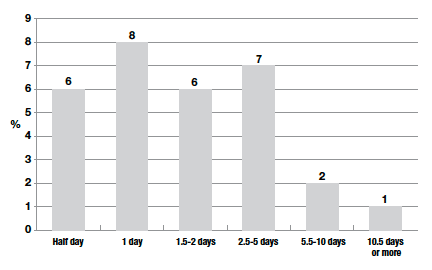
Bases: Weighted bases 2184, unweighted bases 2186
The national level of total primary school attendance has been relatively stable over the last 5 years at around 95%, that is 95% of all possible half days at school were attended (Scottish Government, 2011b). Combined with the data presented above, this may imply that absence, at least at primary school age, is due to the majority of pupils recording short-term absence rather than a minority repeatedly not attending school.
There was no effect of gender for either cohort on self-reported attendance levels. This is in line with previous research that has shown no differences between sexes for overall attendance levels, despite some larger differences in authorised and unauthorised absence.
7.3.2 The effect of deprivation
It is widely reported that levels of absenteeism are higher in deprived areas and that although the effect is larger for secondary school, it is still evident at a younger age. For example, the latest 2010-11 Scottish primary school attendance figures (Scottish Government, 2011b) show a difference of 4 percentage points between children living in areas in the highest and lowest 20% of the Scottish Index of Multiple Deprivation (97% and 93% of all possible half-days attended respectively). Both the child and birth cohort data give some evidence to support this (see Table 7.1). The same official attendance figures also highlight lower attendance levels amongst children living in urban communities compared with those in rural areas, possibly linked to the higher levels of deprivation in some large cities (Scottish Government, 2011b). The GUS data from either cohort does not show any such variation in attendance levels across the different classifications of urban-rurality.
Table 7.1 Attendance at school by SIMD quintile 13
| SIMD Quintile | ||||||
|---|---|---|---|---|---|---|
| Least deprived | 2 | 3 | 4 | Most deprived | Total | |
| Birth | ||||||
| Full attendance in last 6 months | 23 | 21 | 23 | 17 | 19 | 21 |
| Bases | ||||||
| Weighted | 702 | 746 | 687 | 698 | 797 | 3630 |
| Unweighted | 819 | 832 | 736 | 635 | 610 | 3633 |
| Child | ||||||
| Full attendance in last month | 75 | 73 | 72 | 69 | 64 | 71 |
| Bases | ||||||
| Weighted | 444 | 451 | 432 | 373 | 483 | 2184 |
| Unweighted | 500 | 504 | 459 | 337 | 385 | 2186 |
7.3.3 The effect of adjustment
Attendance levels in the first few years at primary school may be influenced by the child's adjustment to school. As Figure 7‑B indicates, those that scored below average on the measure of adjustment to school were less likely to report full attendance than those who scored above average. This was statistically significant in both the child and birth cohorts.
Figure 7‑ B Proportion reporting full attendance and adjustment to school
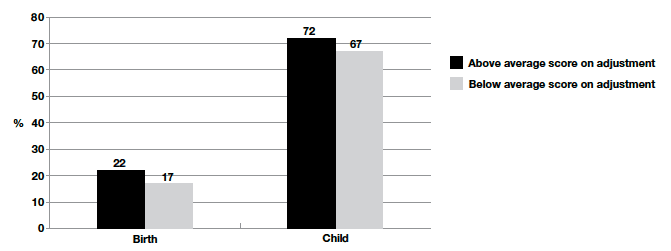
Bases: Birth cohort: Weighted 3349, Unweighted 3352; Child cohort: Weighted 2084, Unweighted 2086.
7.3.4 Reasons for absence
Those respondents that did not report full attendance were asked the reasons for their child's absence. Both cohorts said that child illness was the main reason for time off school, followed by doctor, dentist or hospital appointment. This was irrespective of slight differences in the questions between sweeps. Parents in the child cohort were asked the main reason for absence while those in the birth cohort were asked to report all that applied. The data are summarised in Table 7.2. These findings are similar to those from the Millennium Cohort Study which also found child illness to be the main reason for primary school absence, although this did not distinguish between medical appointments and illness (Hansen, 2010).
Table 7.2 Reasons for absence
| Birth cohort - any reason for absence (multiple answers allowed) % |
Child cohort - main reason for absence (one answer allowed) % |
|
|---|---|---|
| Child illness | 81 | 69 |
| Doctor, dentist or hospital appointment | 39 | 13 |
| Family holiday | 16 | 9 |
| Child refused | 1 | 1 |
| Other reason | 12 | 8 |
| Bases | ||
| Weighted | 2884 | 642 |
| Unweighted | 2853 | 619 |
7.3.5 Sickness
Information on absence from school administrative records is available for the birth cohort. This data allowed more detailed consideration of absence including absence due to sickness over the entire P1 school year.
The administrative data indicate that 76% of GUS sample children reported absence due to sickness in their P1 year. Interestingly, child's health (as reported by the mother) was not significantly associated with whether the child had any time off due to sickness. However, those reporting 'fair or poor' health were significantly more likely to report more days of absence due to sickness.
Figure 7‑ C Proportion recording absence due to sickness and child health
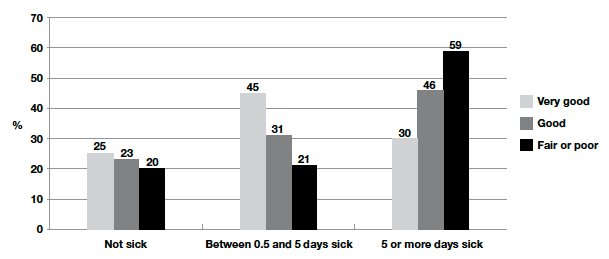
Bases: Weighted 3111, Unweighted 3101
7.3.6 Unauthorised absence
The administrative data on absence also provide figures for the number of unauthorised absences. This showed that, on average, 38% of children in the birth cohort recorded some unauthorised absence during their P1 school year.
Figure 7‑D shows how the amount of unauthorised absence over the year varied by area deprivation. Those children living in areas in the bottom 15% according to deprivation status are more likely to report at least some unauthorised absence. They are also more likely to report more than 2.5 days unauthorised absence.
Figure 7‑ D Proportion recording unauthorised absence from school during P1 by deprivation status
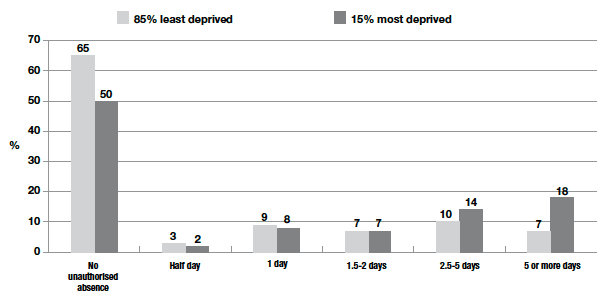
Bases: Weighted 3111, Unweighted 3101
The reasons provided in the administrative data for unauthorised absence are given in Table 7.3. The most common reasons were 'family holiday' and 'truancy', which together accounted for 92% of all unauthorised absences. Deprivation status did influence whether certain reasons were reported. Those in the bottom 15% were more likely to report truancy during P1 compared with the rest of the population (36% versus 12%). Although not significant, there was a trend towards those in the bottom 15% being less likely to report 'family holiday' as a reason for unauthorised absence (18% versus 23% for the rest of the population).
Table 7.3 Number of and reasons for unauthorised absences
| Reason for unauthorised absence | Per cent of all unauthorised absence | Median half days absent | Maximum half days absent | Bases (all with any unauthorised absence) | |
|---|---|---|---|---|---|
| Weighted | Unweighted | ||||
| Family holiday | 51 | 5 | 46 | 675 | 744 |
| Truancy | 41 | 4 | 58 | 482 | 409 |
| Exceptional domestic circumstance | 2 | 2 | 14 | 51 | 45 |
| Other | 7 | 3 | 39 | 132 | 125 |
7.3.7 Lateness
The school administrative data also provided details of lateness to school during the child's Primary 1 year. Forty-four per cent of the birth cohort were recorded as being late at least once during their P1 year. Deprivation status is equally influential on whether a child is late to school or not, as it is on overall attendance levels. As Figure 7‑E shows, the more deprived the quintile, the more likely the child is to have been late during their P1 year, and this is more likely to have happened on multiple occasions.
Figure 7‑ E Lateness at school and deprivation quintile
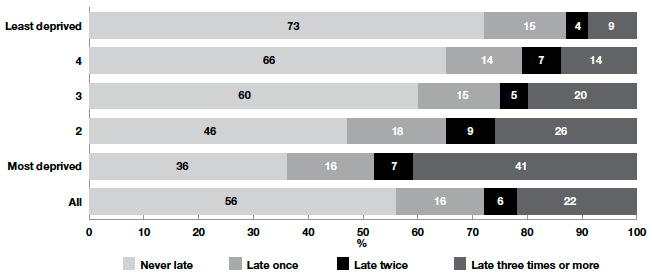
Bases: Weighted 3111, Unweighted 3101
Contact
There is a problem
Thanks for your feedback